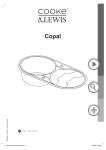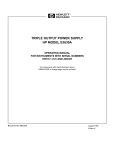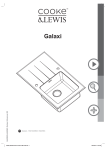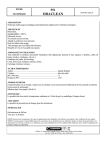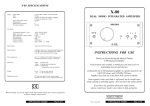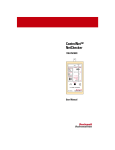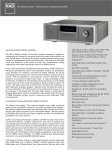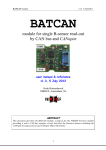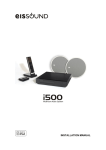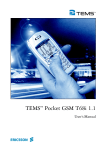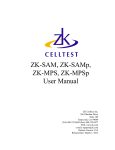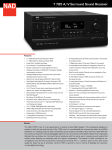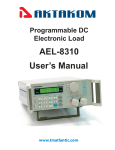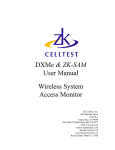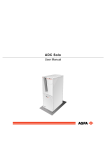Download DX V3.0 Logging Formats
Transcript
ZK Celltest, Inc. 66 DX V3.0 Logging Formats 1.0 Standard DX Data File Structure (& Software Parsing Guidelines) [I think maybe this should be an appendix in the user manual. The channel set, calibration and logging/realtime sections could refer to this appendix. The idea is to provide guidelines for DX datafile users. --Chris]. The basic structure used by DX data files are common between all the data files imported or exported (e.g. channel sets, receiver calibration, realtime logging and log dump files). Any parsing software (e.g Excel macros, scripts, C programs, etc.) may wish to use the following guidelines for parsing any of these files. By following these rules any software (scripts, macros, program, etc.) will be easier to maintain as data file formats evolve to add new features. Of course it is not necessary to follow all of these guidelines, it is up to the data file user to decide if it is appropriate to their specific application. For example, it might be safe to assume in your particular environment that a log file will contain no comment lines -- so if you do not plan to proliferate your parsing scheme to other users who may use comments you could simplify the parsing slightly by not checking for comment lines. 1.1 Overview Here is a quick overview of the standard file format used by the DX -- full details are given below. Basically all DX files are ASCII text which consist of 3 types of lines: • Comment lines (begin with #). Comments are sometimes inserted by the DX itself (to help users interpret a file) or a user can optionally use these lines to make notes. • Control lines (begin with @). Control lines are used to indicate the start and end of data in a file (i.e. @START... and @END). “@ lines” are also reserved for future use such as for keywords. • Message (data) lines. Comma-delimited lines of data. DX836, DX54, DL836 User Manual 67 1.2 General Syntax Guidelines 1.2.1 Ignore Extra Whitespace Any blank lines or other extra white space (e.g. tabs, spaces, new lines, nulls) should be ignored. Also ignore ASCII NUL (Hex code = 0x00) characters. 1.2.2 End of Lines There is a carriage return at the end of each message (ASCII Hex code = 0x0D). 1.2.3 Comments If the first non-whitespace character of a line is '#' then the line should be ignored by the parsing software. The entire line should be considered a comment and ignored. Comments are supported anywhere in a file, e.g. at the beginning before the @START line and between "data" lines. 1.3 Start, End and Control lines “Control lines” are lines which begin with an “@” character. All data files use @START and @END lines to indicate the start and end of data. 1.3.1 Start Line (@START...) The start of data is indicated by a line beginning (first non-whitespace characters) with "@START". Parsing software should ignore any lines before the "@START" line. This line uses white-space delimited fields. Here is an example SAM-ALL realtime output @START line: (model=DX836, SAM-ALL messages version 3.0, firmware version 9.9A) @START ZK-SAM/DX836 SAM-ALL 09/30/1997 14:51:49 3.0 Here is an example SAM-ALL “dump to pc” output @START line: 9.9A @START ZK-SAM/DX836 LOG 09/30/1997 16:32:13 3.0 9.9A ZK Celltest, Inc. 68 The format of the @START line is as follows: TABLE 6. @START line format )LHOG#1DPHV “Dump To PC” Realtime 'DWH 7LPH )LOH 9HUVLRQ 6RIWZDUH 9HUVLRQ ZK-SAM/ DX836 LOG 9/30/97 14:51:49 3.0 9.9A ZK-SAM/ DX836 SAMALL 9/30/97 14:51:49 3.0 9.9A Format revision for FileType Note: V9.9A is example only. 0RGHO @START @START example: SAM-ALL )LOH# 7\SH #67$57 5HVHUYHG Example: Comments: Month/ Hours: Day/ Minutes: Year Seonds Any other data at end of line should be ignored. 1.3.2 End of Data (@END) The end of a data file is indicated by a line beginning with "@END". Parsing software should ignore any data following an @END. Parsing software should ignore data after the @END line until the next @START line. Also parsing software should treat end-of-file as an @END. Note: when transferring any data file [e.g. calibration and channel set data] to a DX the @END line is required. 1.3.3 Other Control (@) Lines Other @ lines may be used by specific file types (e.g. Channel Set). Other @ lines may be used in the future, the best idea for parsing software is to explicity ignore non-specified @ lines. Essentially software should treat these lines like comment lines - i.e. skip them. For example, in a LOG data file the only valid "@ lines" are @START and @END any other line beginning with "@" should be ignored. 1.4 Message (Data) Lines 1.4.1 File Type Specific formats The data format is different for each file type (e.g. SAM-ALL, Channel Set, etc), refer to the appropriate documentation for specific data format information. 1.4.2 Comma-Delimitted Syntax An ASCII comma-delimitted field syntax for message lines. DX836, DX54, DL836 User Manual 69 1.4.3 Extra Fields are Reserved It is possible that formats may change in the future by adding new fields to the end of the existing line formats. Ideally therefore, parsing software should ignore any fields at the end of a line. 1.4.4 End of Lines There is a carriage return at the end of each message line. 70 ZK Celltest, Inc. 2.0 DX V3.0 Realtime and Log Message Formats This section describes the specific messages produced by the SAM-ALL & Select Channel modes. The log data conforms to the standard DX data file format -- please refer to appendix [TBD] for a description of the standard data file structure. To simplify the documentation of SAM-ALL/Select Channel messages are divided into two types: • Non-GPS messages: These messages do not contain GPS information. For example the Date message. • GPS marked messages: These messages all begin with several fields which indicate the message type, time and GPS information. 2.1 About Message Format Tables Below each message is described using a table. The columns of the table are correspond to a single field of the message. The rows of the table give detailed information about the fields. The rows of the table are: • Example -- shows the data from the example message given above the table. • Units -- if applicable gives the units of the message field, e.g. “meters” or “dBm”. • Min/Max -- these to fields (if applicable) give the minimum and maximum values to be expected in the associated message field. • Blank -- “Yes” indicates that the field may be blank under certain conditions. “No” indicates that the field will never be blank. • Comments -- miscellaneous notes about the message field. DX836, DX54, DL836 User Manual 2.2 Non-GPS Messages 2.2.1 Date (DATE) Message This message applies to both SAM-ALL and Select Channel modes. This log is produced at the time SAM-ALL or Select Channel modes are first started. Synopsis: DATE, month/day/year Examples (September 30, 1997 & August 23, 2001): DATE,9/30/1997 DATE,8/23/2001 TABLE 7. Date (DATE) Messages Format )LHOG#1DPHV PHVVDJH W\SH GDWH ([DPSOH#+4<<:, '$7( <26324<<: ([DPSOH#+5334, '$7( ;25625334 8QLWV 0 002''2<<<< 0LQ 0 0 0D[ 0 0 %ODQN 1R 1R &RPPHQWV= 00 5#GLJLW#PRQWK 0 '' 5#GLJLW#GD\ <<<< 7#GLJLW#\HDU 71 ZK Celltest, Inc. 72 2.2.2 System Settings Message This message applies to SAM-ALL mode only. This message is generated at the beginning of a SAM-ALL session. It indicates the scanning mode selected by the user during that SAM-ALL session. Does not apply to Select Channel mode. Synopsis: SS, hour:minute:second, control channel logging selection, voice channel set logging selection Example: SS,14:51:52,CAB,VAB TABLE 8. System Settings(SS) Messages Format )LHOG#1DPHV PHVVDJH W\SH WLPH 66 47=84=85 &$% 9$% 0LQ 0 0 0 0 0D[ 0 0 0 0 %ODQN 1R 1R ([DPSOH &RPPHQWV= 0 FRQWURO#FKDQQHO#VFDQQLQJ#PRGH YRLFH#FKDQQHO#VFDQQLQJ#PRGH 1R 1R SRVVLEOH#YDOXHV= SRVVLEOH#YDOXHV= ++# #5#GLJLW#KRXU ##&$%# #FRQWURO#$#)#% ##9$%# #YRLFH#$#)#% 00 5#GLJLWL#PLQXWH ##&$# #FRQWURO#$#RQO\ ##9$# #YRLFH#$#VFDQQLQJ 66 5#GLJLW#VHFQRG ##&%# #FRQWURO#%#RQO\ ##9%# #YRLFH#%#VFDQQLQJ ##&121(# #QR#FRQWURO#VFDQQLQJ ##9121(# #QR#YRLFH#VFDQQLQJ DX836, DX54, DL836 User Manual 73 2.2.3 GPS Indicator (GP) Message This message applies to SAM-ALL and Select Channel modes. This log is generated at the beginning of a SAM-ALL or Select Channel session to indicate if GPS was enabled. If the unit is non-GPS then this message will always indicate disabled. If the unit does have the GPS option then the user can optionally disable/enable GPS via the GLOBAL SETUP menu (this might be useful for in-building measurements for example). Synopsis: GP, hour:minutes:seconds , flag Example: GP,14:51:52,1 TABLE 9. GPS Indicator Message (GP) Message Format )LHOG#1DPHV ([DPSOH 0LQ PHVVDJH W\SH WLPH *36#HQDEOHG#IODJ 66 47=84=85 4 0 0 3 0D[ 0 0 4 %ODQN 1R 1R 1R ++# #5#GLJLW#KRXU :KHUH#IODJ 4/#WKH#XVHU#KDV#VHW#*36#HQDEOHG1 0 00 5#GLJLWL#PLQXWH :KHUH#IODJ 3/#WKH#XVHU#KDV#VHW#*36#GLVDEOHG/# RU#XQLW#GRHV#QRW#KDYH#*36#RSWLRQ1 &RPPHQWV= 66 5#GLJLW#VHFQRG ZK Celltest, Inc. 74 2.3 GPS Marked Messages The remaining message types all begin with the same fields which give the associated message type, time and GPS information. 2.3.1 Prefix for GPS Marked Messages The “Prefix for GPS Marked Message” is not a message in itself, but is part of all GPS marked messages. Refer to this section for a description of the time and GPS informtion fields associated with GPS marked logs. The same format is used for Select Channel and SAM-ALL modes. Synopsis: Message type, hour:minute:second, latitude, longitude, # of sattelites, HDOP, heading, speed (km/h), altitude (m), ....message-type specific data... Example (GPS Enabled): xx,14:51:52,37.3800,-121.9409,4,3.9,344,59.3,100.6,... Example (GPS Disabled)1: xx,,,,,,,,,,,... TABLE 10. GPS Prefix Format )LHOG#1DPHV PHVVDJH W\SH ([DPSOH WLPH ODWLWXGH ORQJLWXGH VDWHOOLWHV [[ 47=84=85 8QLWV 5#RU#PRUH# FKDUV 0 6:16;33 04541<73< GHJUHHV GHJUHHV 0LQ 0 0 0<3 04;3 4 0D[ 0 1R <3 4;3 %ODQN 1R ++# #5#GLJLW#KRXU <HV4 <HV4 +'23 7 61< KHDGLQJ VSHHG DOWLWXGH 677 8<16 43319 GHJUHHV NP2KU PHWHUV 3 3 3 3 0 0 693 0 0 <HV4 <HV4 <HV4 <HV4 <HV4 0 00 5#GLJLWL#PLQXWH 66 5#GLJLW#VHFQRG &RPPHQWV= PHVVDJH# W\SHV#DUH# GHILQHG# EHORZ1 +RUL]RQWDO 'LOXWLRQ RI 3UHFLVLRQ Notes: [1] The GPS fields are always generated even if the GPS option is not enabled (or installed). There are three reasons that the GPS fields will be blank: (1) GPS is disabled (GPS enabled flag DX836, DX54, DL836 User Manual 75 field of the GP message will be 0) or (2) GPS is enabled (GP message GPS enabled flag = 1) but has not been able to get a fix on enough satellites, or (3) the GPS option is not installed. 2.3.2 Marker (MK) Message This message applies to SAM-ALL and Select Channel modes. Synopsis: MK, hour:minute:second, latitude, longitude, number of satellites, HDOP, heading, speed (km/h), altitude (m), marker number Example: (marker number 11) MK,14:51:52,37.3800,-121.9409,4,3.9,344,59.3,100.6,11 TABLE 11. Marker (MK) Message Format )LHOG#1DPHV PHVVDJH JSV#SUHIL[ W\SH +VHH#VHF#51614, ([DPSOH 0LQ PDUNHU#QXPEHU 0. * 44 0 * 3 0D[ 0 * << %ODQN 1R * 1R * 0DUNHU#QXPEHU#LQFUHPHQWV#HDFK# WLPH#XVHU#LQVHUWV#PDUNHU#+ZLWK# (17(5#NH\#LQ#6$00$//,1##0DUNHU# ZUDSV#WR#3#DIWHU#UHDFKLQJ#<<1## 0DUNHU#QXPEHU#UHWXUQV#WR#3#ZKHQ# ORJ#PHPRU\#FOHDUHG1 &RPPHQWV= 0 ZK Celltest, Inc. 76 2.3.3 Strongest Voice Channel Sets Messages (VA & VB): This message applies to SAM-ALL mode only. The voice channel sets message is a variable length message, which gives the RSSI average, RSSI standard deviation and number of channels for the strongest voice channel sets. The number of voice channel sets logged depends on user selected preferences. Synopsis: V[AB], hour:minute:second, latitude, longitude, # of satellites, HDOP, heading, speed (km/h), altitude (m), strongest set #, strongest set, SAT, Average RSSI, RSSI Standard Deviation, # of channels, ...repeated for up to 21 strongest voice sets... Example: (2 strongest voice sets logged in system A, sets D1 & D3) VA,14:51:53,37.3800,-121.9409,4,3.9,344,59.3,100.6,4,D1,3,-74,3,8,18,D3,3,79,2,13 TABLE 12. Voice Channel Sets Messages (VA & VB) Format )LHOG#1DPHV 5HSHDWHG#IRU#4VW/#5QG111#+XS#WR#54,#VWURQJHVW#VHWV1 PHVVDJH W\SH A Band JSV#SUHIL[ +VHH#VHF#51614, VWURQJHVW VHW#& VWURQJHVW VHW#DEEU1 VA * 4 D1 - * DYJ1 566, VDW 3 566, VWG#GHY &#RI FKDQQHOV -74 3 8 dBm dBm - example Units 1 or 2 chars Min - * 1 - 0 -255 0 0 Max - * 21 - 3 0 255 255 Blank No * No No Yes No No No - Set’s voice channels above XX dBm Comments: * See sec 2.3.1 - - - Blank or 3 means no SAT detected - DX836, DX54, DL836 User Manual 77 2.3.4 Strongest Control Channels Messages (CA & CB) This message applies to SAM-ALL mode only. Synopsis: C[AB], hour:minute:second, latitude, longitude, # of satellites, HDOP, heading, speed (km/h), altitude (m), strongest control channel, RSSI, DCC, second strongest control channel, RSSI, DCC, . . .(repeated for up to 21 control channels) Example: (2 strongest control channels for system A (CA) and system B (CB)) CA,16:27:10,37.3808,-121.9412,6,1.1,344,0.0,17,330,-76,0,316,-84,0 CB,16:27:14,37.3808,-121.9412,6,1.1,344,0.0,17,347,-79,0,349,-88,1 TABLE 13. Strongest Control Channels Messages (CA & CB) Format )LHOG#1DPHV 5HSHDWHG#IRU#4VW/#5QG111#+XS#WR#54,#VWURQJHVW# FRQWURO#FKDQQHOV1 PHVVDJH W\SH A Band JSV#SUHIL[ +VHH#VHF#51614, VWURQJHVW FRQWURO FKDQQHO 566, '&& CA * 330 -76 0 CB * 347 -79 0 - * example B Band example Units dBm Min - * 1 -255 0 Max - * 1023 0 4 Blank No * No No Comments: * See sec 2.3.1 - - - Yes Blank or 4 means no DCC detected ZK Celltest, Inc. 78 2.3.5 System ID message (ID) This message applies to SAM-ALL mode only. This message provides network type, system ID, private system ID and residential system ID information. available on the serving digital control channel. Synopsis: ID, hour:minute:second, latitude, longitude, # of satellites, HDOP, heading, speed (km/h), altitude (m), public network type indicator, private network type indicator, residential network type indicator, SID, PSID1, PSID2, PSID3, PSID4, RSID Example: (SID=31, public network type, no PSID, no RSID) ID,14:53:08,37.3800,-121.9409,4,3.9,344,59.3,100.6,1,0,0,31,,,,, TABLE 14. System ID Message (ID) Format )LHOG#1DPHV PHVVDJH W\SH JSV# SUHIL[ +VHH#VHF# 51614, SXEOLF ID * 1 Min - * Max - * Blank No Example Comments: * * See sec 2.3.1 - 1HWZRUN#7\SH#,QGLFDWRUV SULYDWH V\VWHP ,'# +36,'4, SULYDWH V\VWHP ,'# +36,'5, SULYDWH V\VWHP ,'# +36,'6, SULYDWH V\VWHP ,'# +36,'7, SULYDWH UHVLG0 HQWLDO +SXEOLF, V\VWHP ,'#+6,', 0 0 31 0 0 0 0 0 0 0 0 0 1 1 1 65535 65535 65535 65535 65535 65535 No No No No Yes Yes Yes Yes Yes 0 : ID not available, the associated ID field(s) will be blank. 1 : ID available, the ID value will be indicated by the associated ID field. UHVLGHQWLDO V\VWHP ,'#+56,', Blank indicates ID not available, associated indicator field will be 0. 16-bit values. DX836, DX54, DL836 User Manual 79 2.3.6 Phone (PH) Message This message applies to SAM-ALL mode only. This message provides the key information coming from the phone with the exception of the neighbors. Synopsis: PH, hour:minute:second, latitude, longitude, #sats, PDOP, heading, speed (km/ h), altitude (m), phone type (N6=Nokia2160), control (C) or voice (V) channel, channel number, time slot, set #, set abbr., color code type (DVCC, SAT or DCC), color code value, RSSI, power level, BER, time alignment (TA) Example (IS136 control channel 996A, DVCC=153, RSSI=-83dBm...): PH,14:53:19,37.3800,121.9409,4,3.9,344,59.3,100.6,N6,C,996,A,4,D1,DVCC,153,-83,2,0,, TABLE 15. Phone (PH) Message Format )LHOG#1DPHV PVJ1 W\SH ([DPSOH 8QLWV 0LQ 3+ 0 0 0D[ *36#SUHIL[ +VHF#51614, SKRQH W\SH - 19 & - 4#RU# PRUH# FKDUV 4#FKDU - 4 0 - 54 0 %ODQN 1R &RPPHQWV= FKDQQHO#& WLPH#VORW VHW& VHW DEEU1 - 1R <HV#5 19 5493 SRVVLEOH= & FRQWURO 9 YRLFH FRORU FRGH W\SH FRORU FRGH YDOXH 566, SRZHU OHYHO 0;6 5 3 G%P VHH QRWH#4 ( %(5 WLPLQJ DOLJQPHQW <<9 $ 7 '4 '9&& 486 0 0 0 4#RU# 5 FKDUV 4#RU# PRUH# FKDUV 0 4 $ 4 0 0 3 0588 3 3 3 4356 & 54 43 433 64 0 '9&& 588 '&& 7 6$7 6 3 0 1R <HV <HV <HV <HV <HV <HV SRVVL0 EOH= ##'9&&/ ##6$7#RU ##'&& %ODQN#RU# '&& 7/# 6$7 6# LQGLFDWHV# FRORU#FRGH# QRW#DYDLO0 DEOH1 0 -#6HH#VHF# 51614 0 FKDQQHO W\SH <HV#5 <HV 1R EODQN# QRW#7'0$ 0 0 0 0 VHH QRWH#4 0 0 Notes: [1] Power level value is equal to Mobile Station Power Level (PL) as defined by the IS136 specification. PL can be converted to dBW (PdBW) with the following equation: PdBW = 6dBW - (PL * 4dBW) [e.g. PL=1 is 2dbW] [2] If channel # is blank it implicates a power-off event of the phone. ZK Celltest, Inc. 80 2.3.7 Neighbor List (NB) Message This message applies to SAM-ALL mode only. This message logs the neighbor list data as measured by the phone. The neighbors are ordered from strongest to weakest. Synopsis: NB, hour:minute:second, latitude, longitude, # of satellites, PDOP, heading, speed (km/h), altitude (m), serving channel number, serving time slot, serving set #, serving set abbr., serving DVCC, serving RSSI, strongest neighbor channel, strongest neighbor RSSI, strongest neighbor DVCC, . . . (neighbors repeated to max provided by system, sorted strongest RSSI to weakest) Example: (serving channel=996A, strongest neighbor=715, 2nd strongest neighbor=708 ...) NB,14:53:19,37.3800,-121.9409,4,3.9,344,59.3,100.6,996,A,4,D1,153,-83,715,85,153,708,-93,153,695,-103,111,711,-104,162,693,-105,43,992,-105,162,1002,106,43 TABLE 16. Neighbor List (NB) Message Format )LHOG#1DPHV 1HLJKERU#&KDQQHO#,QIRUPDWLRQ 5HSHDWHG#IRU#DOO#QHLJKERUV# SURYLGHG#E\#V\VWHP#+XS#WR#57#PD[,1## 2UGHU#LV#VRUWHG#E\#566,/#VWURQJHVW# 566,#ILUVW/#ZHDNHVW#ODVW11 6HUYLQJ#&KDQQHO#,QIRUPDWLRQ PHVVDJH W\SH JSV#SUHIL[ +VHH#VHF#51614, VHW FKDQQHO WLPH#VORW VHW#& DEEU1 '9&& 566, FKDQQHO ([DPSOH 8QLWV 1% - <<9 $ 7 0 - 0 0 0 '4 4#RU#5 FKDUV 566, '9&& 486 0;6 :48 0;8 486 0 G%P 0 G%P 0 0LQ 0 - 4 $ 4 0 3 0588 4 0588 3 0D[ 0 - 4356 & 54 0 588 3 4356 3 588 %ODQN 1R - 1R <HV 1R 1R <HV <HV 1R <HV <HV 0 -#6HH#VHF#51614 0 0 0 0 0 0 0 0 0 &RPPHQWV= DX836, DX54, DL836 User Manual 81 2.3.8 Interference (IA & IB) Messages This message applies to SAM-ALL mode only. When an adjacent channel interference event occurs the data is logged in this message. Synopsis: I[AB], hour:minute:second, latitude, longitude, #sats, PDOP, heading, speed (km/h), altitude (m), upper (U) or lower (L) adjacent, C/I, serving channel set #, serving channel set abbr., serving channel #, serving time slot, serving RSSI, serving color code type, serving color code value, power level, BER, time alignment (TA), adjacent set #, adjacent set abbr., adjacent channel #, adjacent RSSI Examples: (system A, serving channel=996, lower adjacent channel=995...) IA,14:54:55,37.3800,-121.9409,4,3.9,344,59.3,100.6,L,22,4,D1,996,C,68,DVCC,153,4,0,0, 5,E1,995,-90 TABLE 17. Interference (IA & IB) Messages Format )LHOG#1DPHV Serving Channel Information message type $#EDQG ,$ gps prefix (see sec 2.3.1) interference type C/I - / 55 - 4#FKDU G%P color code value Adjacent Channel Info set # set abbr. chan # time slot RSSI color code type power level (PL) BER timing alignment 7 '4 <<9 & 09; '9&& 486 7 3 3 G% P 4#RU# PRUH# FKDUV 3 0 4# FKD U VHH ( 4 $ 0 588 0 3 3 435 6 & 3 '9&& 5 88 set # set abbr. chan # RSSI 8 (4 <<8 0<3 ([DP0 SOH 8QLWV 4#RU# 5 0 0LQ 0 0D[ FKDU V - 0 0 045; 4 45: 54 0 0 0 0 QRWH# 4 4#RU# 5 G%P 0 0 3 3 4 4 0588 43 433 64 435 6 435 6 3 <HV <HV <HV 1R 1R 1R 1R 0 0 0 0 FKDU V 0 '&& 7 6$7 6 %ODQN 1R &RP0 PHQWV= - 1R -#6HH# SRVVL0 VHF#51614 EOH= 0 #/=# ORZHU0# DGMD0 FHQW1 #8=# XSSHU0 DGMD0 FHQW 1 R FDU0 ULHU# WR# LQWHI0 HUHQ FH 1R 1R <H V <HV <HV SRVVL0 EOH= 0 0 0 0 0 <HV %ODQN#RU# '&& 7/# 6$7 6# ## '9&&/ LQGL0 FDWHV# ##6$7# FRORU# RU FRGH#QRW# ##'&& DYDLO0 DEOH1 VHH QRWH 4 0 ZK Celltest, Inc. 82 [1] Power level value is equal to Mobile Station Power Level (PL) as defined by the IS136 specification. PL can be converted to dBW (PdBW) with the following equation: PdBW = 6dBW - (PL * 4dBW) [e.g. PL=1 is 2dbW] 2.3.9 Individual Voice Channel RSSI (RA & RB) Messages This message applies to SAM-ALL mode only. If the user selects a scanning mode that includes voice channel scanning and selects more than zero individual voice channels to store then these messages will log the top XX voice channels and their signal strength where XX ranges from 0 to 40 and is settable by the user in the MORE SAM-ALL SETUP SCREEN. Synopsis: R[AB], hour:minute:second, latitude, longitude, #sats, PDOP, heading, speed (km/h), altitude (m), channel1, channel1 RSSI, channel2, channel2 RSSI, . . . Examples: (system A, channels 78,99, 996,246 . System B channels 486, 463, 722, 591) RA,19:01:25,37.3800,-121.9409,4,3.9,344,59.3,100.6,78,-71,99,-72,996,75,246,-75 RB,19:01:31,37.3800,-121.9409,4,3.9,344,59.3,100.6,486,-51,463,-52,722,61,591,-62 TABLE 18. Individual Voice Channel RSSI (RA & RB) Messages Format )LHOG#1DPHV PHVVDJH JSV#SUHIL[ W\SH +VHH#VHF#51614, &KDQQHO#,QIRUPDWLRQ 5HSHDWHG#IRU#WKH#QXPEHU#RI #FKDQQHOV#FRQILJXUHG#E\#WKH#XVHU1 6RUWHG#E\#566,/#VWURQJHVW#WR#ZHDNHVW1# FKDQQHO#QXPEHU $#EDQG 566, 5$ - :; 0:4 5% - 7;9 084 ([DPSOH %#EDQG ([DPSOH 8QLWV 0 - 0 G%P 0LQ 0 - 4 0588 0D[ 0 - 4356 3 %ODQN 1R - 1R 1R 0 -#6HH#VHF#51614 0 0 &RPPHQWV= DX836, DX54, DL836 User Manual 83 2.3.10 Select Channel (CN) Log: This message applies to Select Channel mode only. ....description goes here.... Synopsis: CN, hour:minute:second, latitude, longitude, # of satellites, PDOP, heading, speed (km/h), altitude (m), channel1, channel1 RSSI, channel1 SAT, channel1 DCC, ... Example: (channel 255, RSSI=-56dBm, SAT=1, channel 779, RSSI=-56dBm, no color code, ...) CN,13:41:26,42.0613,-87.7518,7,1.2,115,5.9,200,255,-56,1,,779,-56,,,993,104,,,1022,-106,,,629,-105,,,1,-97,1, TABLE 19. Select Channel (CN) Message Format )LHOG#1DPHV &KDQQHO#,QIRUPDWLRQ 5HSHDWHG#IRU#WKH#QXPEHU#RI #FKDQQHOV#FRQILJXUHG#E\#WKH#XVHU1# PHVVDJH JSV#SUHIL[ W\SH +VHH#VHF#51614, $#EDQG &1 - FKDQQHO#QXPEHU 566, 6$7 588 089 4 '&& ([DPSOH 8QLWV 0 - 0 G%P 0 0 0LQ 0 - 4 0588 3 3 0D[ 0 - 4356 3 6 7 %ODQN 1R - 1R 1R <HV <HV 0 -#6HH#VHF#51614 0 0 &RPPHQWV= %ODQN#RU#6$7 6# %ODQN#RU#'&& 7# LQGLFDWHV#QR#6$7# LQGLFDWHV#QR# DYDLODEOH1 '&&#DYDLODEOH1



















